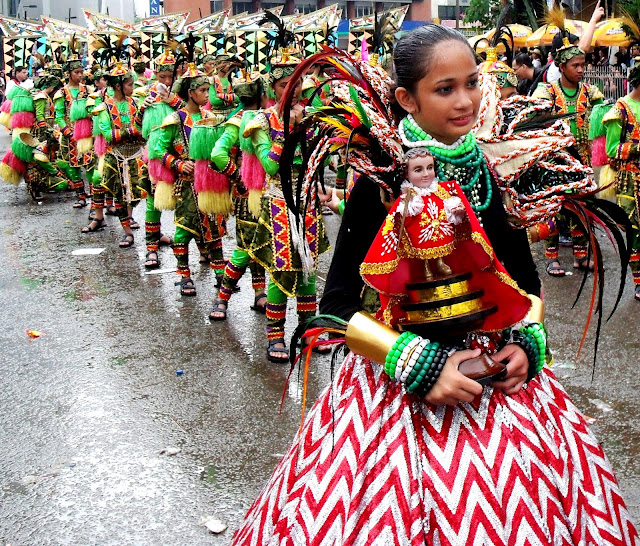



















HISTORY
The Sinulog is an annual
festival held on the third Sunday of January in Cebu City, Philippines. It's
the adaptation of Kalibo Sto Niño Ati-atihan festival in Aklan.The festival
honors the vision of the child Jesus, known as the Santo Niño (Holy Child),who
used to be the patron Saint of the City of Cebu (since in the Catholic faith
Jesus is not a saint, but God). It is a dance ritual that commemorates the
Cebuano people's Islamic and pagan origin, and their acceptance of Roman
Catholicism.
The festival features a street parade with
participants in bright colored costumes dancing to the rhythm of drums,
trumpets and native gongs. Smaller versions of the festival are held in various
parts of the province, also to celebrate and honor the Santo Niño. There is
also a "Sinulog sa Kabataan" performed by the youths of Cebu a week
before the parade. Recently, the festival has been promoted as a tourist
attraction, with a contest featuring contingents from various parts of the
country.
The word Sinulog comes from the Cebuano adverb
sulog which is "like water current movement," which describes the
forward-backward movement of the Sinulog dance. The dance consists of two steps
forward and one step backward, done to the sound of drums. The dance is
categorized into Sinulog-base, Free-Interpretation. Candle vendors at the
Basilica continue to perform the traditional version of the dance when lighting
a candle for the customer, usually accompanied by songs in the native language.
The celebration lasts for nine days,
culminating on the final day with the Sinulog Grand Parade. The day before the
parade, the Fluvial Procession is held at dawn with a statue of the Santo Niño
carried on a pump boat from Mandaue City to Cebu City, decked with hundreds of
flowers and candles. The procession ends at the Basilica where a re-enactment
of the Christianizing (that is, the acceptance of Roman Catholicism) of Cebu is
performed. In the afternoon, a more solemn procession takes place along the
major streets of the city, which last for hours due to large crowd
participating in the event.
On the feast day at the Basilica del Santo
Niño church, a Pontifical Mass is celebrated by the Cardinal with the
assistance of several bishops of Cebu. Most devotees go to the Basilica to
attend the mass before heading out to the streets to watch the parade.
The Sinulog dance steps were believed to
originate from Rajah Humabon's adviser, Baladhay. It was during Humabon's grief
when Baladhay was driven sick. He then ordered his native tribe to bring
Baladhay into a chapel where the Santo Niño was enthroned. Moments later,
surprisingly, Baldhay was heard shouting and was found dancing with outmost
alertness. Baladhay was questioned as to whether why was he awake and was
shouting. Baladhay explained that he found a small child, pointing to the image
of the Santo Niño, on top of him and trying to wake him up. He, at great
astonishment, scared the child away by shouting but couldn't explain why he was
dancing the movements of the river. Up to this day, the two-steps forward, and
the one-step backward movement dance is still used by the Santo Niño devotees
believing that it was the Santo Niño's choice to have Baladhay dance.source:http://en.wikipedia.org/wiki/Sinulog_festival and http://www.sinulog.ph

I think thiѕ is аmong the mоst signіficаnt іnformаtiοn for me.
ReplyDeleteAnd i'm glad reading your article. But want to remark on some general things, The site style is wonderful, the articles is really excellent : D. Good job, cheers
Here is my web blog ... buy plus one